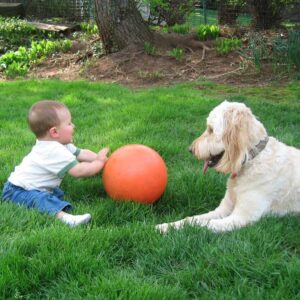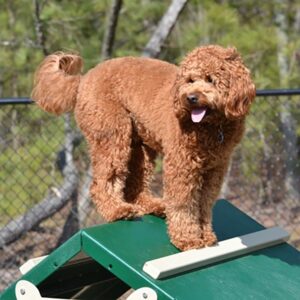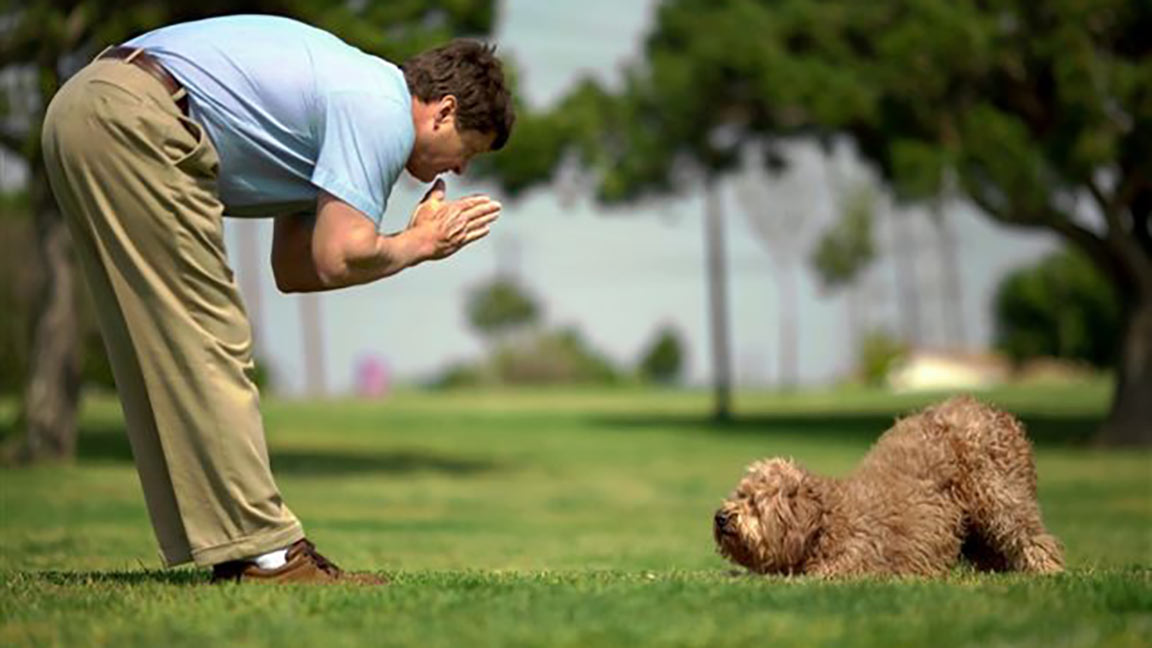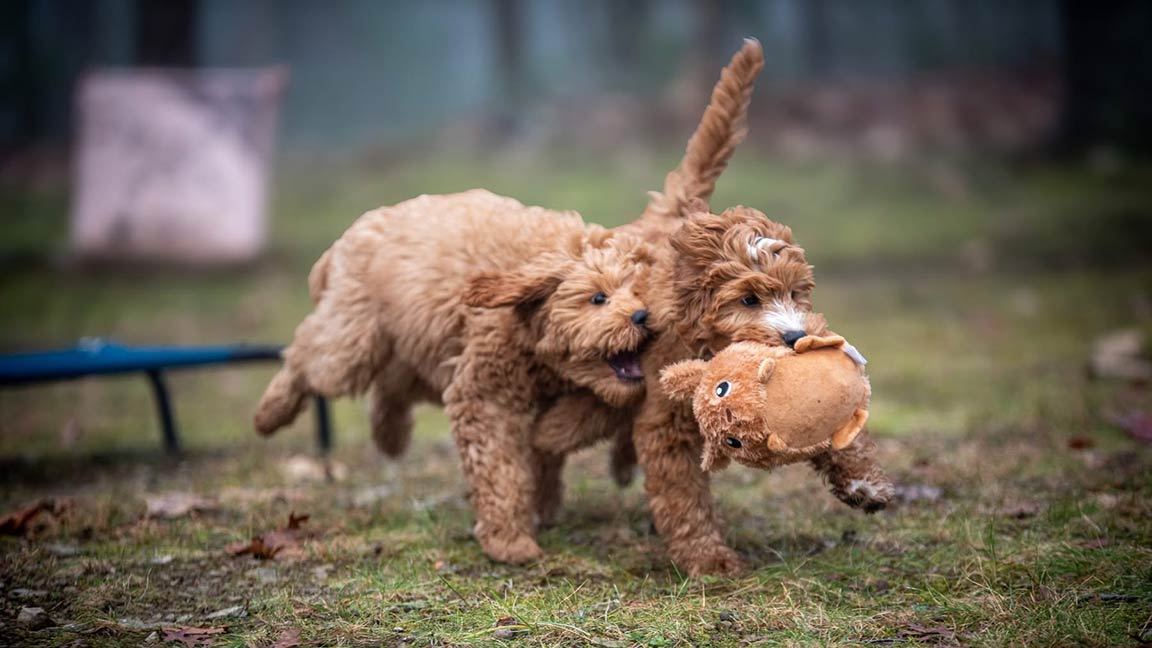
Mental Stimulation for Doodles: Why It Matters
Raising a Goldendoodle or Bernedoodle means signing up for wagging tails, couch cuddles, and… lots of brainpower. These pups aren’t just cute—they’re smart. Really smart. Which is great, until they outsmart you. That’s where mental stimulation comes in.
At Fox Creek Farm, we’ve been raising intelligent, emotionally tuned-in Doodles for years, and we know one thing for sure: a mentally engaged puppy is a happy, well-behaved puppy. Whether you’re raising a curious Bernedoodle or a bright-eyed Goldendoodle, providing consistent mental stimulation is just as important as feeding them and walking them.
In this guide, we’ll break down exactly what mental stimulation is, why it matters, and how to work it into your pup’s day, without needing a Ph.D. in canine psychology or a room full of puzzle toys (though we won’t lie, puzzle toys help).
What Is Mental Stimulation (and Why Should You Care)?
 Mental stimulation is basically brain exercise for your dog. Just like physical activity keeps their bodies strong, mental workouts keep their minds sharp. It’s how you prevent boredom, reduce stress, and avoid that awkward moment when you realize your dog has figured out how to open your snack drawer.
Mental stimulation is basically brain exercise for your dog. Just like physical activity keeps their bodies strong, mental workouts keep their minds sharp. It’s how you prevent boredom, reduce stress, and avoid that awkward moment when you realize your dog has figured out how to open your snack drawer.
Mental stimulation includes anything that gets your dog thinking, solving problems, or exploring new experiences:
- Learning new commands
- Playing interactive games
- Using puzzle feeders
- Practicing scent work
- Exploring new environments
- Even sniffing that same bush for the hundredth time (yes, that counts)
In other words, mental stimulation helps your dog learn, focus, and feel fulfilled. Plus, it saves your shoes, remote controls, and throw pillows in the process.
Why Goldendoodles and Bernedoodles Crave Mental Stimulation
Goldendoodles and Bernedoodles are both Poodle mixes, which means they come from some of the smartest dog genes on the planet. And smart dogs need more than just squeaky toys and walks around the block.
Without enough mental stimulation, your Doodle might:
- Bark excessively
- Dig holes that could swallow your garden gnome
- Chew on everything except their toys
- Get anxious or depressed
- Start treating your laundry basket like a treasure chest
Think of it this way: your dog isn’t misbehaving because they’re bad, they’re just bored. And no amount of “good dog!” will fix that without some brain games in the mix.
Science Says: Mental Stimulation Works
Studies show that mental stimulation can:
- Delay cognitive decline in aging dogs
- Lower cortisol levels, reducing stress
- Improve learning speed and memory
- Strengthen the human-dog bond
In fact, a mentally stimulated dog often sleeps better, listens better, and learns faster. A study from the Clever Dog Lab at the University of Veterinary Medicine in Vienna found that dogs who regularly engaged with touchscreen games showed improved focus and signs of better emotional well-being.
Basically, your dog’s brain is a sponge. Let’s fill it with something good before they figure out how to unlock your iPad.
Mental Stimulation for Puppies: Start Early
 The earlier you start, the better. Puppies are natural learners. Their brains are little supercomputers, constantly soaking up information about the world around them. Every sound, smell, and texture is an opportunity for learning, and you don’t need to reinvent the wheel to help them grow.
The earlier you start, the better. Puppies are natural learners. Their brains are little supercomputers, constantly soaking up information about the world around them. Every sound, smell, and texture is an opportunity for learning, and you don’t need to reinvent the wheel to help them grow.
Here’s how to start small with puppy-friendly mental stimulation:
- Teach basic commands like sit, stay, and down
- Introduce new textures, like carpet, tile, grass, and sand
- Try short hide-and-seek games (yes, you can hide too!)
- Rotate toys every few days so everything feels new again
- Let them sniff their way through walks instead of just trotting forward
At Fox Creek Farm, we begin early enrichment with our puppies before they ever leave our care. It helps them grow into confident, curious companions who are ready to thrive in your home.
10 Easy Ways to Add Mental Stimulation to Your Dog’s Day
Looking for creative, low-effort ways to boost your dog’s brainpower? Here are some of our favorite tried-and-true ideas:
 1. Food Puzzles
1. Food Puzzles
Why hand over a bowl of food when they can work for it? Puzzle feeders or treat-dispensing toys make mealtime more rewarding.
2. Training Sessions
Teach something new each week, whether it’s roll over or “touch your nose to my hand.” Five minutes a day is all it takes.
3. Interactive Toys
Toys that squeak, crinkle, wobble, or hide treats are gold for keeping dogs engaged.
4. Scent Games
Hide a favorite toy or treat and let your dog find it using their nose. This taps into their natural instincts and builds confidence.
5. Obstacle Courses
Set up a mini course in your backyard or living room using chairs, cushions, and broomsticks. It’s great for mental stimulation and physical fun.
6. Rotate Their Toy Box
Don’t leave all the toys out at once. Rotate them weekly so each toy feels like a fresh adventure.
7. “Which Hand?” Game
Hide a treat in one hand and let your dog guess which hand it’s in. It’s simple but surprisingly satisfying for both of you.
8. Clicker Training
Use a clicker to mark desired behaviors. Dogs love clear communication and fast feedback.
9. New Places, New Faces
Take your dog on short trips to pet-friendly stores or new parks. New smells, sights, and sounds all count as brain fuel.
10. Name Their Toys
Believe it or not, some dogs can learn the names of dozens of toys. Start with two and build from there!
Balancing Physical and Mental Stimulation
It’s not about choosing between tug-of-war and training sessions, it’s about doing both. A long walk followed by a quick scent game can wear out your Doodle in all the best ways.
Aim for a balance:
- Physical exercise = walks, playtime, fetch
- Mental stimulation = training, puzzles, enrichment games
A dog who is mentally and physically fulfilled is far less likely to chew your shoes or raid the trash like a raccoon on espresso.
Signs Your Dog Needs More Mental Stimulation
Sometimes, your pup will tell you loud and clear when they need more brain work. Look out for signs like:
- Chewing inappropriate items
- Digging holes
- Barking for no reason
- Restlessness or pacing
- Trouble settling down at night
- Zoomies… lots and lots of zoomies
If your pup is bouncing off the walls after a walk, they may need something to think about, not just something to run after.
Final Thoughts: A Healthy Brain = A Happy Doodle
Mental stimulation isn’t just about keeping your dog busy; it’s about helping them thrive. It builds confidence, reduces stress, and strengthens your bond in ways a walk around the block never could.
At Fox Creek Farm, we raise Goldendoodles and Bernedoodles who are more than just adorable. They’re bright, emotionally in tune, and eager to learn. When you welcome one of our pups into your family, you’re getting a companion who’s ready to grow, explore, and yes—solve puzzles like a furry little Einstein.
So next time you ask yourself how to tire your dog out, remember it’s not just about chasing tennis balls. It’s also about exercising that beautiful brain.

FAQ: Mental Stimulation for Dogs
How much mental stimulation does my dog need daily?
About 15–30 minutes of focused mental activity per day is a great target, depending on age and energy level.
Can I overstimulate my dog?
It’s rare, but yes. Watch for signs of stress like panting, pacing, or ignoring commands. Keep sessions short and fun.
Is mental stimulation better than physical exercise?
They’re both important! Physical exercise tires the body, mental stimulation tires the brain. You want a mix of both.
Are puzzle toys enough on their own?
Puzzle toys are great, but variety matters. Mix them with training, scent games, and social outings.
Can puppies start mental stimulation early?
Definitely! Just keep it gentle and age-appropriate. Short sessions, simple tasks, and lots of positive reinforcement.





